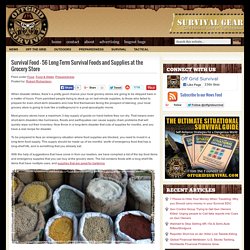

Long Term Food Storage. Foodsaver Sealing Mason Jars~Rice & Long Term Food Storage. Dry-Packing Food Storage At An LDS Home Storage Center. Food Storage Basics: Step 1 – Water. What does water have to do with food storage?

Well, you can have all the food in the world but if you don’t have water you won’t be living long enough to enjoy that food. In most cases, you’ll be around for only three days. One easy way to remember this is with the 3-3-3 rule. Generally speaking you cannot live longer than 3 minutes without air, 3 days without water, and 3 weeks without food. In an ideal world, we would all have a years supply of water stored away. Here’s some helpful pointers:You should have at least one gallon per person, per day, for 14 days: 14 days acts as a buffer zone that gives you time until the infrastructure problem is fixed or at least until you can figure out other water-procurement methods. Storing water is an easy step. Food Storage Basics: Step 3 – Long Term Storage. At this point, you should have 2-weeks worth of water stored away (or more if you live in areas where natural sources of water are hard to find).

You should also have a three-month supply of food and other necessities that you are continually using and replacing. Once those are all set, the next step is to now start thinking about your longer-term needs. When I refer to ‘longer-term needs’ I’m talking about storing a years worth of food or more. While the food that typically goes into a 3-months rotating supply generally needs to be eaten within a few months to a year, your ‘long-term’ storage will contain those items that will last much much longer — typically 10 – 30 years or more. These are foods that you will use to stay alive, such as wheat, white rice, and beans. Before you throw your hands up in despair, don’t feel you need to go out and buy a whole years worth in one setting.
Remember with all of this, take it one step at a time. Food Storage Basics: Step 4 – Non-Food Items. Once you’ve secured enough food for one year, you are well on your way to becoming a master squirrel, he he.

All jokes aside, if you’ve followed each of the previous steps you should now have 2-weeks worth of water, a three-month supply of food and other necessities that is continually rotated, and you should be working towards a years supply of long-term food items. The next step — Step 4 — is really just an extension of Step 3. You can do this step in tandem with procuring your year’s supply of food or you can finish Step 3 first before moving on to this step. The only thing I’d recommend is that you focus on the food items first and foremost. Fight Food Fatigue: 20 Oft-Forgotten Items In Your Long Term Food Storage. One of the major mistakes people make with regards to food storage is buying a huge amount of one or two staples (ie rice and beans or wheat and powdered milk) and nothing else.

While there’s no problem with storing thousands of pounds of wheat, if that’s all you have you are going to suffer from a serious case of appetite fatigue in a short time. Appetite or food fatigue in simple term can be described as a phenomenon whereby eating the same foods over and over cause you to become disinterested in eating. In the best of cases it will cause minor malnutrition but in severe cases it can lead to starvation – despite being hungry. Though this may sound ridiculous it is a very real phenomenon, especially during times of stress (something that a SHTF situation would probably promote), and young children and older people are particularly susceptible to it.
Like a mantra I’m sure you’ve heard the advice, “store what you eat, and eat what you store”. Butter Substitute For Food Storage. Food Storage - Top 10 Foods To Get Now. Survival Food – 56 Food Supplies From The Grocery. When disaster strikes, there’s a pretty good chance your local grocery stores are going to be stripped bare in a matter of hours.

From panicked people trying to stock up on last minute supplies, to those who failed to prepare for even short-term disasters and now find themselves facing the prospect of starving, your local grocery store is going to look like a battleground in a post-apocalyptic movie. Most grocery stores have a maximum 3 day supply of goods on hand before they run dry. That means even short-term disasters like hurricanes, floods and earthquakes can cause supply chain problems that will quickly wipe out their inventory. Now throw in a long-term disaster that cuts of supplies for months, and you have a real recipe for disaster. To be prepared to face an emergency situation where food supplies are blocked, you need to invest in a long-term food supply. Survival Food that adds flavor & comfort: SaltSugar – Brown or WhiteRaw HoneyAlcohol – Whiskey, Vodka, etc… Oils: Resources: